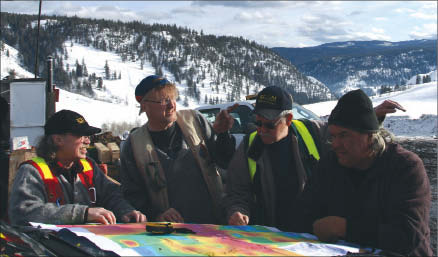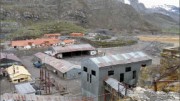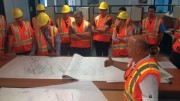If you’ve ever been to Princeton, home to the recently opened Copper Mountain mine, you’ve also seen Sego Resources’ (SGZ-V) Miner Mountain copper property.
Sego’s project sits on a treeless hilltop overlooking the town. The hill dominates the local scenery, and everyone passing through town is sure to have looked up at it. Company geologists joke that they can order a pizza while on the property and watch the delivery car the whole way as it goes from the pizzeria to the project.
And with Copper Mountain Mining’s (CUM-T) waste-rock piles clearly visible on the horizon 20 km south of Princeton, the Sego geologists are constantly reminded that copper, as well as pizza, can be found in the region.
But while Copper Mountain and Miner Mountain both saw exploration in the early 1900s, Copper Mountain went into production as a high-grade mine in the 1920s and Miner Mountain was thought of as a coal prospect. It wasn’t until the 1950s that Miner Mountain, with no outcrop and a healthy layer of glacial till, was noted for copper.
From 1951 to the early 2000s the property then saw no less than 14 companies try their hand at finding a viable copper deposit, some drilling a few holes and others giving up after sample programs. Most efforts targeted the Granby, Regal and South zones, with little apparent regional exploration.
Doug Hopper first explored the area in 1995, conducting soil geochemistry to the north and south of historical workings and finding encouraging anomalies, while a few years later NuStar Resources, working with geologist Jim McLeod, drilled a few holes and hit copper. But by 2002, exploration at the property had petered out.
The most recent attempt at the property did not take shape until 2006, when J. Paul Stevenson, who had formed Sego Resources the year before, took an interest in the property and talked to Hopper and McLeod about optioning it. With little money in Sego at the time, Stevenson had to put off signing a deal, but his interest — and the apparent lack of other suitors — allowed him to later secure the property.
“I was the only guy telling them this was good, so they waited for me,” Stevenson says with one of his jovial chuckles.
Sego signed a deal in mid-2007, agreeing to pay $165,000 cash and 600,000 shares for 100% of the 17.2-sq.-km property. Sego has issued the cash and half the shares, while the other half is due when a feasibility study is complete. The vendors hold a 3% net smelter return royalty, half of which can be bought for $1.5 million.
The company started with soil sampling, bulldozer trenching, a Titan 24 induced-polarization survey and limited drilling to corroborate earlier exploration, and possibly reinterpret findings.
Early drilling confirmed copper mineralization in microdiorite and Nicola volcanic rocks, with hole 8-4 hitting 64 metres grading 0.46% copper, 0.14 gram gold per tonne and 2.58 grams silver, and hole 8-9 returning 53 metres averaging 0.41% copper, 0.12 gram gold and 2.11 grams silver from 26 metres, with both holes ending in mineralization.
After mixed success in 2009 and 2010 with trenching and modest diamond drilling, the company knew there was mineralization on the established zones. But with no outcrop and complicated geology, the company was looking for a different approach. Since Sego was looking for a large alkali copper-gold porphyry along the lines of Copper Mountain, New Afton, Mount Polly and others along the Quesnel-Stikine Terrane, Stevenson tried the same tool used to find most of B.C.’s big porphyries: percussion drilling.
“They’re cheap and fast, the two most important things in exploration,” Stevenson says, noting that the drills were once common as a prospecting tool but for some reason are almost unknown today.
“There’s a whole generation or two that don’t know anything about percussion drills,” Stevenson says, explaining that he couldn’t find one in B.C. and had to track one down in Alberta.
Percussion drilling doesn’t replace diamond drill core by any means, and can’t be used for resource calculation, but when faced with a few metres of glacial till and no outcrop, the drill can be an efficient option. Stevenson says the drilling costs are about a third of what diamond drilling comes to, which allowed the company to perform a more systematic exploration of the property on a limited budget.
The drilling punched through 10 metres of overburden to the Cuba zone, where percussion drilling yielded 52 metres grading 1.26% copper, 1.06 grams gold and 3.79 grams silver. Follow-up on the zone further pushed mineralization to the southeast, with Sego reporting in January that it hit 82 metres averaging 1% copper, 0.58 gram gold and 1.69 grams silver from 18 metres, ending in mineralization at 100 metres depth.
Stevenson credits the greater flexibility of percussion drilling. Its cost allows for more drilling while finding the new area of mineralization.
“There was nothing to tell us there was anything over there,” Stevenson says.
With percussion drilling less reliable for grade and not showing structure — not to mention that it’s hardly taken seriously by the market — Sego launched a follow-up diamond drill program earlier this year to twin holes and test the extension of mineralization at the Cuba zone. The results largely confirm the grades of percussion drilling and show mineralization could continue at depth.
Of the four vertical diamond drill holes, hole 21 hit 100 metres carrying 0.95% copper, 0.55 gram gold and 3.47 grams silver from 10 metres depth; 100 metres east-southeast hole 23 cut 32 metres averaging 0.17% copper and 0.23 gram gold; 100 metres farther southeast hole 24 returned 128 metres averaging 0.34% copper, 0.3 gram gold and 1 gram silver; and 100 metres farther east hole 26 hit 12 metres averaging 1.16% copper and 0.76 gram gold.
Angled to the southeast, diamond drill hole 28, collared just south of hole 21, returned 70 metres averaging 0.26% copper and 0.19 gram gold, and southeast-angled hole 27, collared between holes 23 and 24, hit 88 metres averaging 0.22% copper and 0.19 gram gold.
The company reports that core logging points to a large package of highly altered Nicola group volcanics to a depth of 300 metres, with alteration varying in intensity from whole rock replacement to lightly altered rock with preserved textures. Mineralization ranges from chalcopyrite-bornite with pyrite to pyrite alone, with chalcopyrite and bornite occurring in fine-grained net textures to massive disseminations throughout the rock at the highest grades.
Drilling indicates that mineralization is open in all directions, with Sego planning to expand near-surface mineralization and explore for deeper mineralization.
The company, however, has yet to announce plans for its next exploration phase. When working with complicated porphyries Stevenson prefers to work slower, with a manageable amount of data. The Miner Mountain property has lots of faulting and structural activity that makes it good for mineralization, but much tougher to interpret. For now Stevenson is happy the company is on the right track.
“The trick with porphyries is figuring them out, but at least we’re getting the grades to know it’s worth figuring out,” Stevenson says.
He says he’s been approached by majors about possible option deals, but that the project is too early stage to give up so much.
“Optioning a property is go
od for the property, but not for shareholders,” Stevenson says.
At the end of December the company had about half a million in cash, so it will have to raise more money to explore. The company has 54.6 million shares out and recently hit a 52-week trading high of 36¢ on the diamond drill results. Sego also has 18 million warrants out at 11¢ and almost 8 million options out at 16¢.
Stevenson is joined in management by a team he’s worked with for close to 20 years, including Sego president Chris Sampson and directors Allan Hilton and Shelley Hallock, while the board includes newer entrants Andrew Watson and Tyler Ducharme.
Much of the team formerly ran Pacific Booker Minerals (BKM-V), but a disagreement in 2005 with a major U.S.-based shareholder on development priorities saw the whole team jump ship rather than be caught in a protracted proxy battle. The boardroom scuffle led to what is now Sego Resources.
And now Sego, with its enthusiastic geologic team and sometimes unconventional approach, is working hard to figure out the hilltop Miner Mountain deposit, and maybe one day give Princeton a new landmark.






Be the first to comment on "Sego set to scale Miner Mountain"